 loading
loading loading
loading
featuresWish you were hereAntique postcards reveal views of a Yale most of us never saw.
By Mark Alden Branch ’86
|
Sep/Oct 2021
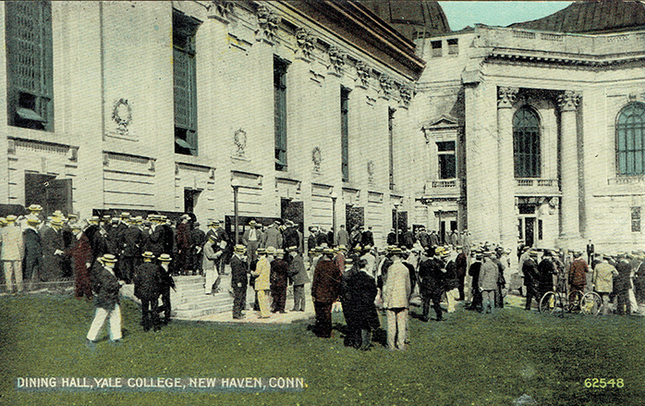 Courtesy Pat Marino CollectionYale’s Bicentennial buildings—Commons, Memorial Hall, and Woolsey Hall—are familiar to present-day Yalies, but this view from the 1920s looks a little different. The current giant Corinthian columns on Commons (which were added as part of a World War I memorial in 1927) are still to come, and the boater hat–wearing gentlemen are standing amid a green lawn that has since been replaced by a stone plaza. View full image Courtesy Pat Marino CollectionYale’s Bicentennial buildings—Commons, Memorial Hall, and Woolsey Hall—are familiar to present-day Yalies, but this view from the 1920s looks a little different. The current giant Corinthian columns on Commons (which were added as part of a World War I memorial in 1927) are still to come, and the boater hat–wearing gentlemen are standing amid a green lawn that has since been replaced by a stone plaza. View full image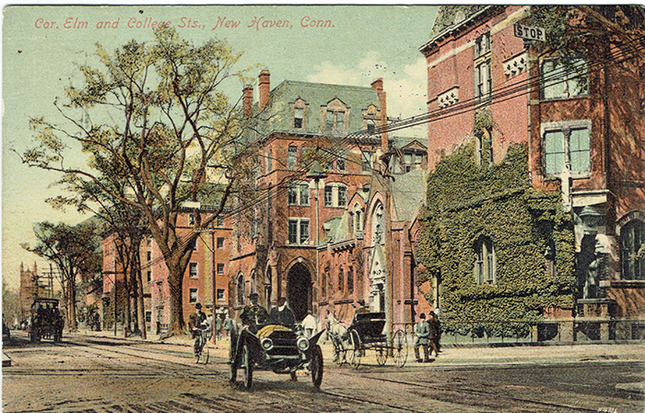 Courtesy Pat Marino CollectionThe old Divinity School buildings at College and Elm were built mostly in the 1870s in Victorian Gothic style. They were demolished in 1931 to make room for Calhoun College (now Grace Hopper College), as were the buildings of the Berkeley Oval in the background. View full image Courtesy Pat Marino CollectionThe old Divinity School buildings at College and Elm were built mostly in the 1870s in Victorian Gothic style. They were demolished in 1931 to make room for Calhoun College (now Grace Hopper College), as were the buildings of the Berkeley Oval in the background. View full image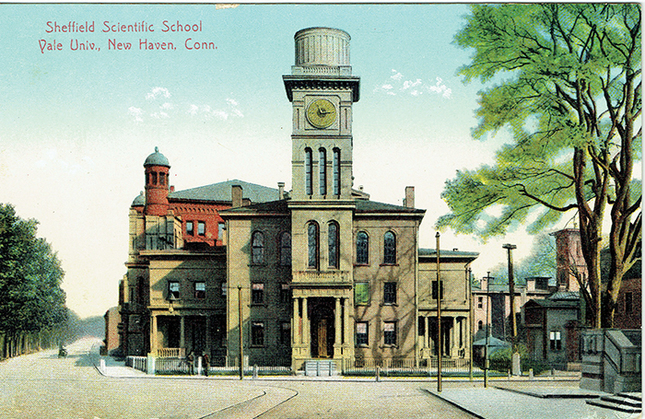 Courtesy Pat Marino CollectionBefore the building known as Sterling-Sheffield-Strathcona rose at the corner of Grove and Prospect in 1932, that corner was home to Sheffield Hall, flagship building of the Sheffield Scientific School. It was also home to the School of Medicine from 1814 to 1860; rumors of a secret tunnel to the cemetery next door to facilitate cadaver theft are greatly exaggerated. (The body snatching, unfortunately, was real.) View full image Courtesy Pat Marino CollectionBefore the building known as Sterling-Sheffield-Strathcona rose at the corner of Grove and Prospect in 1932, that corner was home to Sheffield Hall, flagship building of the Sheffield Scientific School. It was also home to the School of Medicine from 1814 to 1860; rumors of a secret tunnel to the cemetery next door to facilitate cadaver theft are greatly exaggerated. (The body snatching, unfortunately, was real.) View full image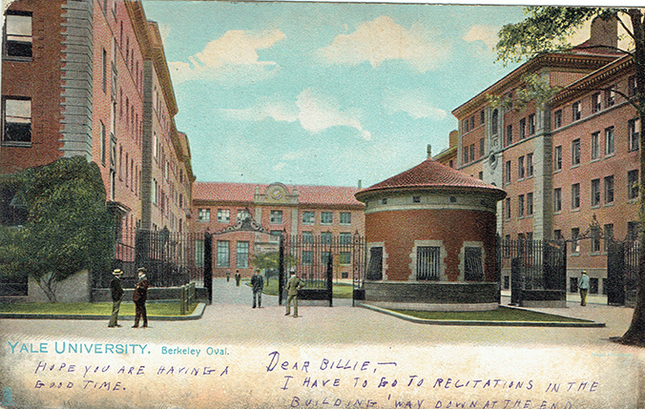 Courtesy Pat Marino CollectionThe Berkeley Oval, Yale College’s first big expansion north of Elm Street, comprised five buildings that served as dormitories, classrooms, lecture halls, and offices. Built between 1894 and 1909, they lasted less than 40 years before being demolished to make way for Berkeley College and Cross Campus. The round building in the foreground was Yale’s telephone exchange. View full image Courtesy Pat Marino CollectionThe Berkeley Oval, Yale College’s first big expansion north of Elm Street, comprised five buildings that served as dormitories, classrooms, lecture halls, and offices. Built between 1894 and 1909, they lasted less than 40 years before being demolished to make way for Berkeley College and Cross Campus. The round building in the foreground was Yale’s telephone exchange. View full image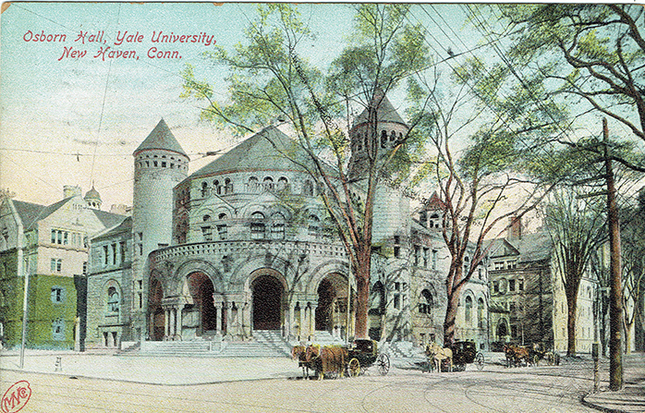 Courtesy Pat Marino CollectionThe exuberant Romanesque style of Osborn Hall at College and Chapel did little to cheer students and alumni who resented the removal of the hallowed Yale Fence to make room for the building in 1888. By 1926, it was considered an eyesore, and the noise from streetcars made it ill-suited to its purpose as a classroom building. Osborn was replaced by Bingham Hall. View full image Courtesy Pat Marino CollectionThe exuberant Romanesque style of Osborn Hall at College and Chapel did little to cheer students and alumni who resented the removal of the hallowed Yale Fence to make room for the building in 1888. By 1926, it was considered an eyesore, and the noise from streetcars made it ill-suited to its purpose as a classroom building. Osborn was replaced by Bingham Hall. View full image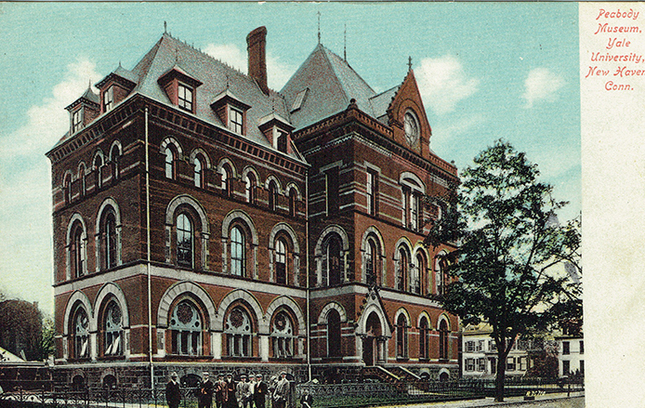 Courtesy Pat Marino CollectionThe first iteration of the Peabody Museum was a Victorian Gothic building at the corner of High and Elm, where Saybrook College stands now. It was completed in 1876 and razed in 1917. View full image Courtesy Pat Marino CollectionThe first iteration of the Peabody Museum was a Victorian Gothic building at the corner of High and Elm, where Saybrook College stands now. It was completed in 1876 and razed in 1917. View full image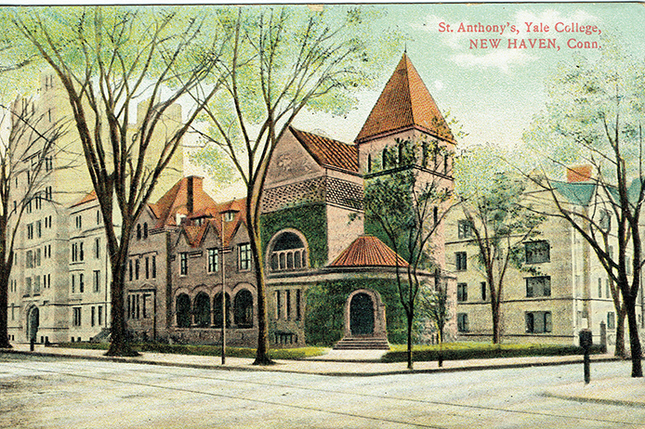 Courtesy Pat Marino CollectionEven shorter-lived was the eccentric home of St. Anthony Hall, a Sheffield School fraternity that built this Richardsonian Romanesque building in 1885 at College and Wall and added the residential wing at left in 1894. The whole thing was scrapped in 1913 and replaced with a new St. Anthony Hall that matched the Sheffield School’s adjacent limestone Gothic dormitories. (The dorms eventually became part of Silliman College; St. A’s is still there, scarcely distinguishable from its neighbors.) View full image Courtesy Pat Marino CollectionEven shorter-lived was the eccentric home of St. Anthony Hall, a Sheffield School fraternity that built this Richardsonian Romanesque building in 1885 at College and Wall and added the residential wing at left in 1894. The whole thing was scrapped in 1913 and replaced with a new St. Anthony Hall that matched the Sheffield School’s adjacent limestone Gothic dormitories. (The dorms eventually became part of Silliman College; St. A’s is still there, scarcely distinguishable from its neighbors.) View full image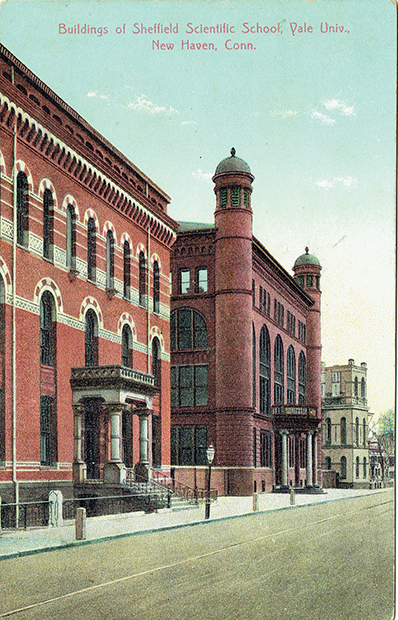 Courtesy Pat Marino CollectionJust like Yale College, the Sheffield School had its own Victorian period, when these buildings on Prospect Street were erected. At left is North Sheffield Hall (1873–1967), which housed classrooms and offices, and in the center is Winchester Hall (1892–1967), home to civil engineering. (At far right is the previously mentioned Sheffield Hall.) Winchester and North Sheff came down in 1967 to make way for the Becton Engineering Center. History of Art professor Vincent Scully ’40, ’49PhD, protested their removal, anticipating the nascent preservation movement in his argument that “if they could live 20 years more they would never be torn down.” View full image Courtesy Pat Marino CollectionJust like Yale College, the Sheffield School had its own Victorian period, when these buildings on Prospect Street were erected. At left is North Sheffield Hall (1873–1967), which housed classrooms and offices, and in the center is Winchester Hall (1892–1967), home to civil engineering. (At far right is the previously mentioned Sheffield Hall.) Winchester and North Sheff came down in 1967 to make way for the Becton Engineering Center. History of Art professor Vincent Scully ’40, ’49PhD, protested their removal, anticipating the nascent preservation movement in his argument that “if they could live 20 years more they would never be torn down.” View full image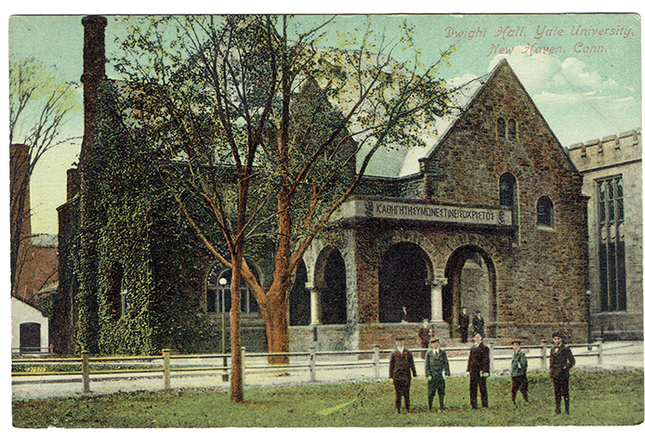 Courtesy Pat Marino CollectionBefore Dwight Hall was an organization, it was a building on the High Street side of the Old Campus that housed Yale’s YMCA branch. Built in 1886, it was demolished in 1926, with little complaint. A newspaper article of the time explained that “Dwight Hall, like Osborn Hall, seemed to spoil the old campus.” Observers noted the enhanced view of Harkness Tower from Old Campus once the building was gone. Dwight Hall, the Christian and public-service organization, soon got a new permanent home in the Old Library, where it remains today. View full image Courtesy Pat Marino CollectionBefore Dwight Hall was an organization, it was a building on the High Street side of the Old Campus that housed Yale’s YMCA branch. Built in 1886, it was demolished in 1926, with little complaint. A newspaper article of the time explained that “Dwight Hall, like Osborn Hall, seemed to spoil the old campus.” Observers noted the enhanced view of Harkness Tower from Old Campus once the building was gone. Dwight Hall, the Christian and public-service organization, soon got a new permanent home in the Old Library, where it remains today. View full image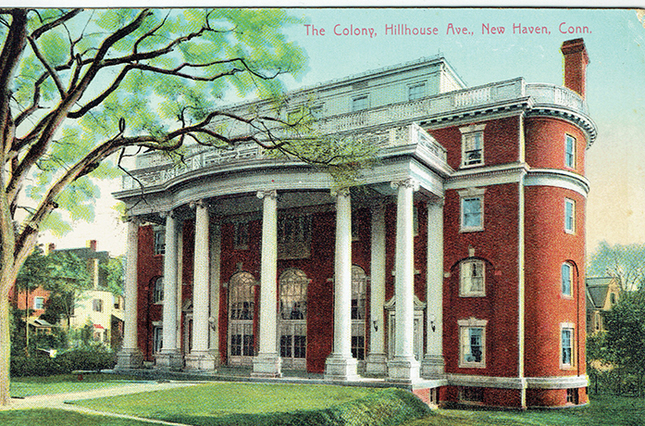 Courtesy Pat Marino CollectionA number of campus buildings started their lives as fraternity houses. One that didn’t survive was Colony, the residential home of the Berzelius society, which stood proudly on Hillhouse Avenue. Built in 1898, it was sold to Yale in 1933 and demolished in 1967; the Yale Health Center was built on the site in 1971. View full image Courtesy Pat Marino CollectionA number of campus buildings started their lives as fraternity houses. One that didn’t survive was Colony, the residential home of the Berzelius society, which stood proudly on Hillhouse Avenue. Built in 1898, it was sold to Yale in 1933 and demolished in 1967; the Yale Health Center was built on the site in 1971. View full image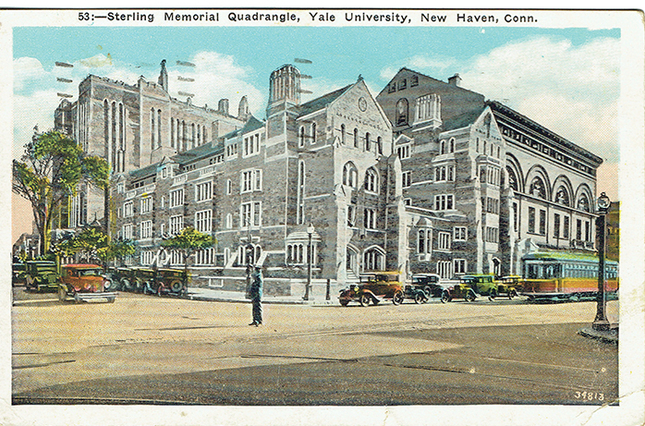 Courtesy Pat Marino CollectionThis view of the corner of Elm and York captures an unusual architectural moment in the early 1930s: Sterling Memorial Library and the dormitories of the Sterling Quadrangle had been completed, but the Old Gymnasium (at right in photo) still stood in the midst of the new buildings. The old gym would soon be replaced by a dining hall as the quadrangle became Trumbull College. View full image Courtesy Pat Marino CollectionThis view of the corner of Elm and York captures an unusual architectural moment in the early 1930s: Sterling Memorial Library and the dormitories of the Sterling Quadrangle had been completed, but the Old Gymnasium (at right in photo) still stood in the midst of the new buildings. The old gym would soon be replaced by a dining hall as the quadrangle became Trumbull College. View full image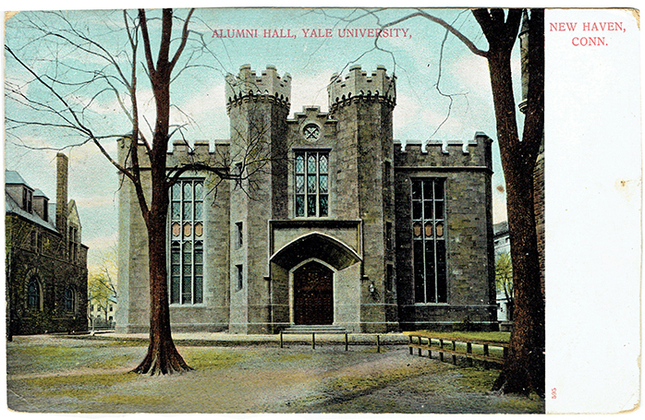 Courtesy Pat Marino CollectionAlumni Hall, which contained examination halls and the libraries of three Yale literary societies (Linonia, Brothers in Unity, and Calliope), anchored the northwest corner of Old Campus from 1853 to 1911. It was replaced by Wright Hall (now Lanman-Wright). But at least some of the building lives on: the entrance towers were rebuilt behind Skull and Bones at the entrance to the Art Gallery sculpture garden. View full image Courtesy Pat Marino CollectionAlumni Hall, which contained examination halls and the libraries of three Yale literary societies (Linonia, Brothers in Unity, and Calliope), anchored the northwest corner of Old Campus from 1853 to 1911. It was replaced by Wright Hall (now Lanman-Wright). But at least some of the building lives on: the entrance towers were rebuilt behind Skull and Bones at the entrance to the Art Gallery sculpture garden. View full image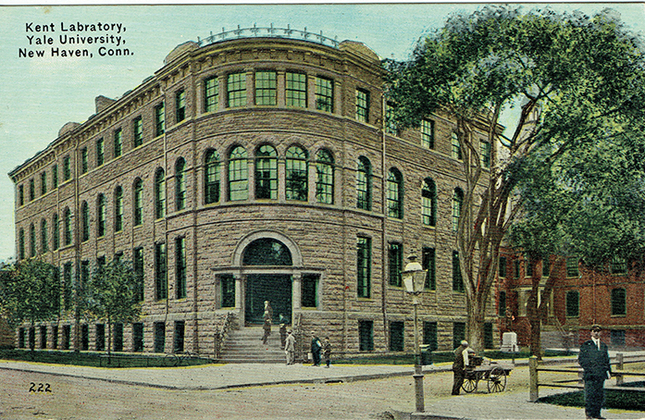 Courtesy Pat Marino CollectionKent Chemical Laboratory stood at the corner of High and Library Streets, where Jonathan Edwards College is now. It was around from 1888 to 1931. View full image Courtesy Pat Marino CollectionKent Chemical Laboratory stood at the corner of High and Library Streets, where Jonathan Edwards College is now. It was around from 1888 to 1931. View full image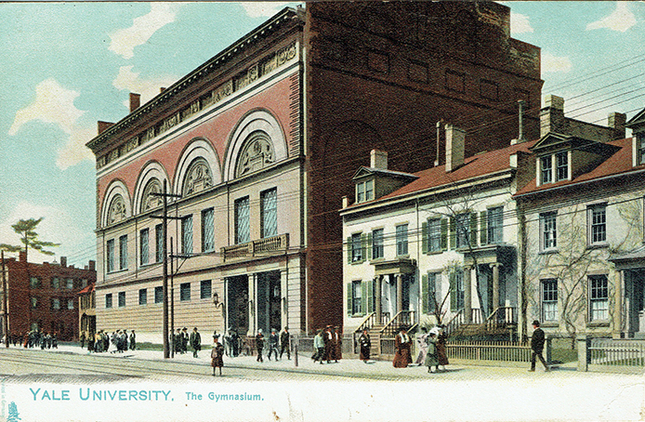 Courtesy Pat Marino CollectionFrom 1892 to 1932, before Payne Whitney, Elis worked up a sweat in the Renaissance Revival–style University Gymnasium on Elm Street. Inside were Russian and Turkish baths, a domed “tepidarium” for drying off, a pool, bowling alleys, rowing tanks, and a clear-span gymnasium topped with a skylight. View full image Courtesy Pat Marino CollectionFrom 1892 to 1932, before Payne Whitney, Elis worked up a sweat in the Renaissance Revival–style University Gymnasium on Elm Street. Inside were Russian and Turkish baths, a domed “tepidarium” for drying off, a pool, bowling alleys, rowing tanks, and a clear-span gymnasium topped with a skylight. View full image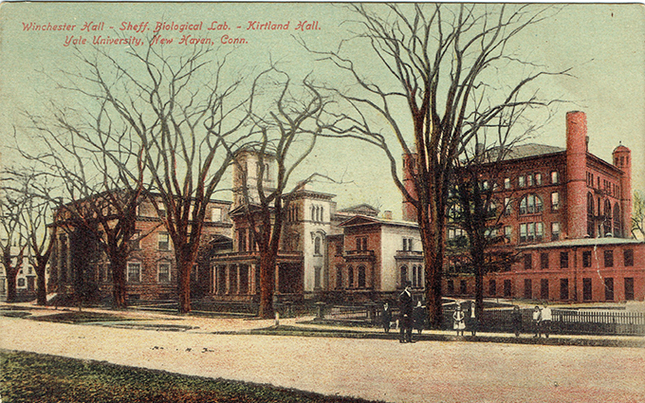 Courtesy Pat Marino CollectionOne of the grandest houses on Hillhouse Avenue was Joseph Sheffield’s. This view shows the house after it became a Yale lab. Designed in 1836 by Ithiel Town and later expanded by Henry Austin, the house met its end in 1957, replaced by an addition to Dunham Lab. Also seen on this card are Winchester Hall, at right, and Kirtland Hall—which is still standing—at left. View full image Courtesy Pat Marino CollectionOne of the grandest houses on Hillhouse Avenue was Joseph Sheffield’s. This view shows the house after it became a Yale lab. Designed in 1836 by Ithiel Town and later expanded by Henry Austin, the house met its end in 1957, replaced by an addition to Dunham Lab. Also seen on this card are Winchester Hall, at right, and Kirtland Hall—which is still standing—at left. View full image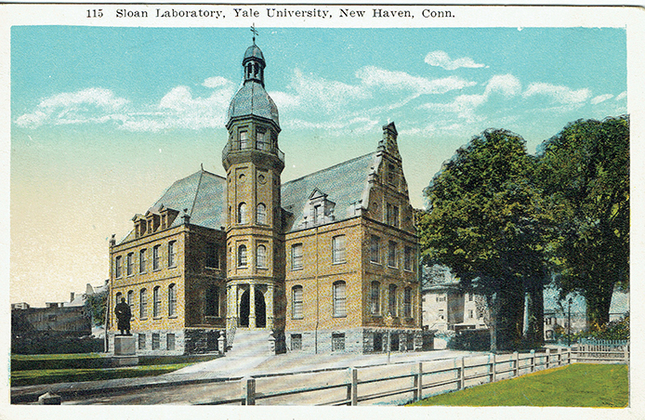 Courtesy Pat Marino CollectionThe prominent tower of the Sloane Physical Laboratory must have cut quite a figure on the skyline when it was built and completed in 1883. Like Kent Laboratory, which was next door on Library Street, it was demolished in 1931 to make way for Jonathan Edwards College. View full image Courtesy Pat Marino CollectionThe prominent tower of the Sloane Physical Laboratory must have cut quite a figure on the skyline when it was built and completed in 1883. Like Kent Laboratory, which was next door on Library Street, it was demolished in 1931 to make way for Jonathan Edwards College. View full imageBack before Google Street View, before smartphone cameras—even before cheap color photography—people still wanted to document the places they found special. They did it by buying and sending postcards, engraved from photographs and printed in colors that were sometimes less true than aspirational.
|
Copyright 2015 Yale University. All rights reserved. As of July 1, 2015, the Yale Alumni Magazine operates as a department of Yale University. Earlier print and digital content of the Yale Alumni Magazine was published and copyrighted by Yale Alumni Publications, Inc., and is used under license.

 9 comments
9 comments Print
Print Email
Email
9 comments
-

Stewart Landefeld, 10:44am August 20 2021 |  Flag as inappropriate
Flag as inappropriate
-

Gary Lavorgna, 2:18pm August 30 2021 |  Flag as inappropriate
Flag as inappropriate
-

Ken Bernier, 9:42am September 16 2021 |  Flag as inappropriate
Flag as inappropriate
-

Joanne Porto, 11:56am September 16 2021 |  Flag as inappropriate
Flag as inappropriate
-

Avis Qenani, 3:41pm September 16 2021 |  Flag as inappropriate
Flag as inappropriate
-

Robert S. Greenberg, 10:17pm September 16 2021 |  Flag as inappropriate
Flag as inappropriate
-

Elaine G. Chu, 10:43am September 18 2021 |  Flag as inappropriate
Flag as inappropriate
-

Beth Morrow, 1:03pm September 18 2021 |  Flag as inappropriate
Flag as inappropriate
-

Tracy MacMath, 2:11pm September 18 2021 |  Flag as inappropriate
Flag as inappropriate
The comment period has expired.Thank you for a wonderful feature on this many-year-effort collection! Congratulations and thanks to Mr. Marino, and let's find Mr. Marino's collection a deserving home!
I had the privilege of working with Pat in my capacity as a Journeyman Locksmith in Physical Plant. Pat was the most thoroughly prepared planner when he and I interacted on large rekeying projects during the Universities’s major renovations during the 1990’s. During my time as Senior Groundskeeper on Old Campus I witnessed his dedication to the massive renovation of Harkness Tower, where a huge crane was placed in the middle of High St. to lift materials and tradesmen. Pat was there every day, often with his camera recording this historic project to stabilize and replace the crumbling exterior materials. Thank you for sharing his post card collection.
Beautiful images and amazing to keep history alive through postcards. I had the pleasure of dropping off my daughter Allison 'Class of 25' at Yale and I can relate to these beautiful postcard images. Thanks for sharing these - they are worth preserving forever.
What a wonderful collection of historical postcards. As I tried to imagine what the properties and buildings looked like way back when and what stands now, I was reminded that Yale has always been a leader of change - architecturally, politically and socially. As a native New Havener, I'm proud of Yale's every-changing and deepening roots in the Elm City.
Wow! What a treat! Thank you so much Mr. Marino for bringing us views of Yale under a different lens! So special.
This collection is fabulous Pat! I would be very interested in building an exhibit around this amazing collection at Lost in New Haven. I am creating a great space for Yale University’s history in New Haven and these beautifully colored depictions of Yale’s past would be a very cool background for it. People should be able to view your collection and it should remain intact for future generations. I can be emailed at: [email protected] if interested in discussing any ideas if interested in such a presentation. Robert.
Lovely historical collection of Yale postcards. Interesting architecture. Had no idea what previous buildings had looked like. Kudos to Mr. Marino for his service at Yale and for finding these postcards over the years.
I looked at these postcards in the paper version of the Yale Alumni Magazine. While they are great photos, I was mostly struck by the fact that, over and over, Yale has torn down extraordinary buildings after very short time periods. This pattern is incredibly wasteful, reflects poor planning, and is a sign that Yale just has (and has always had) too much money for its own good. My takeaway from these postcards: give my money to an institution that needs it more.
Give them to the University archives!